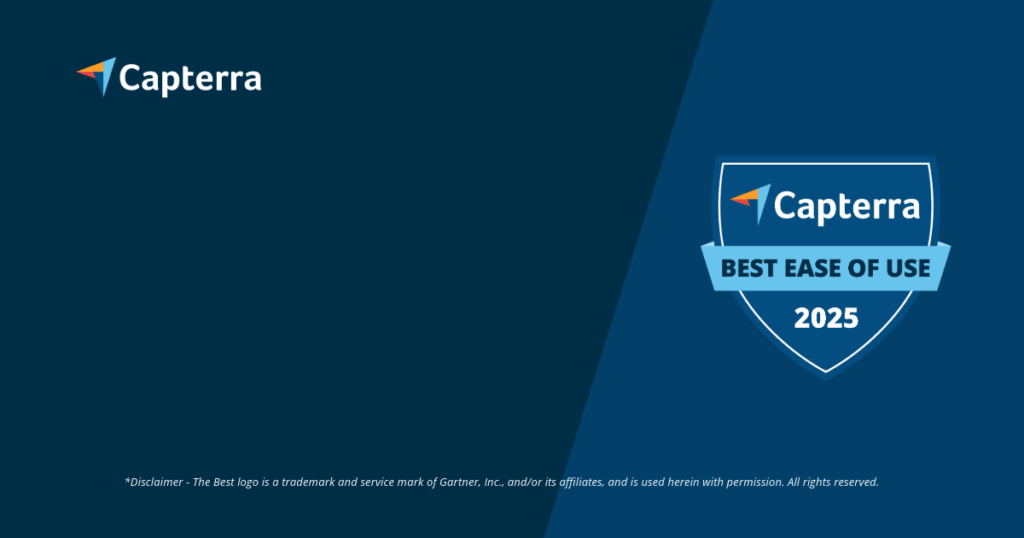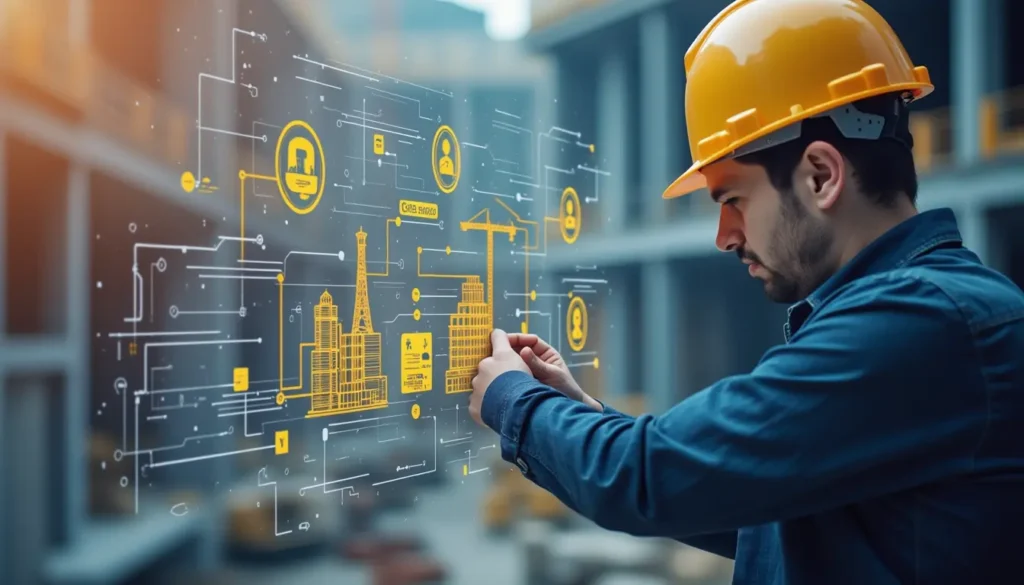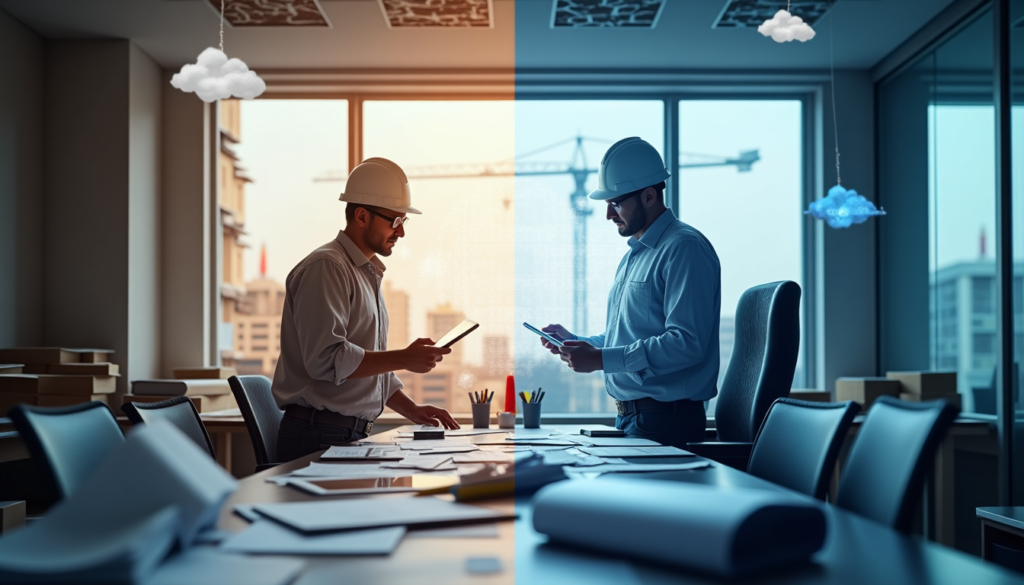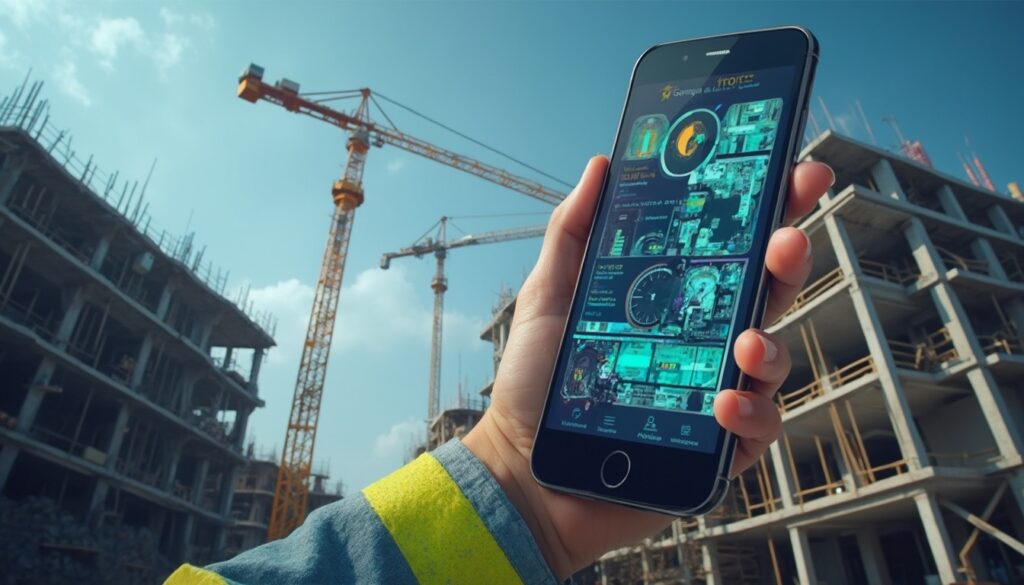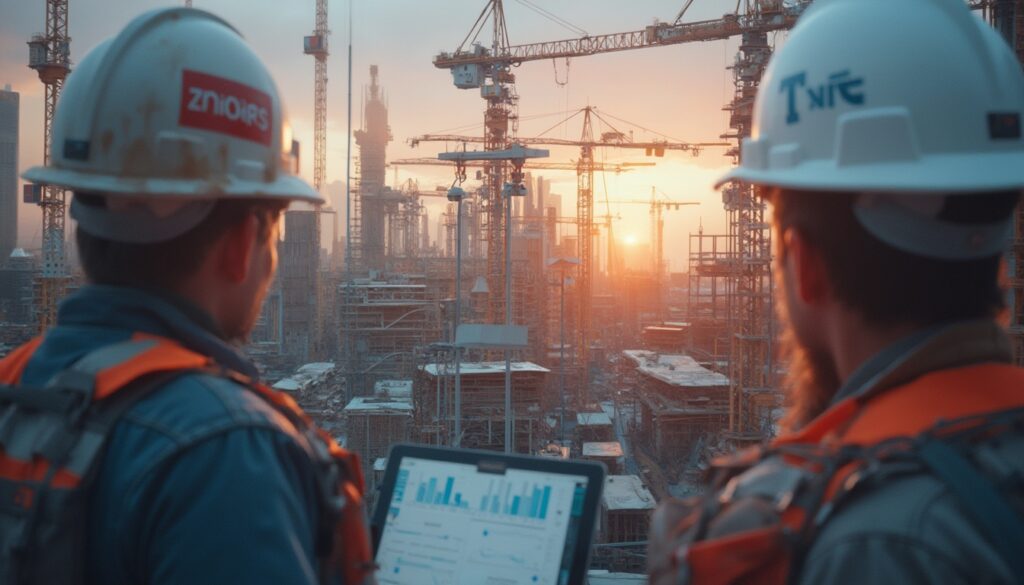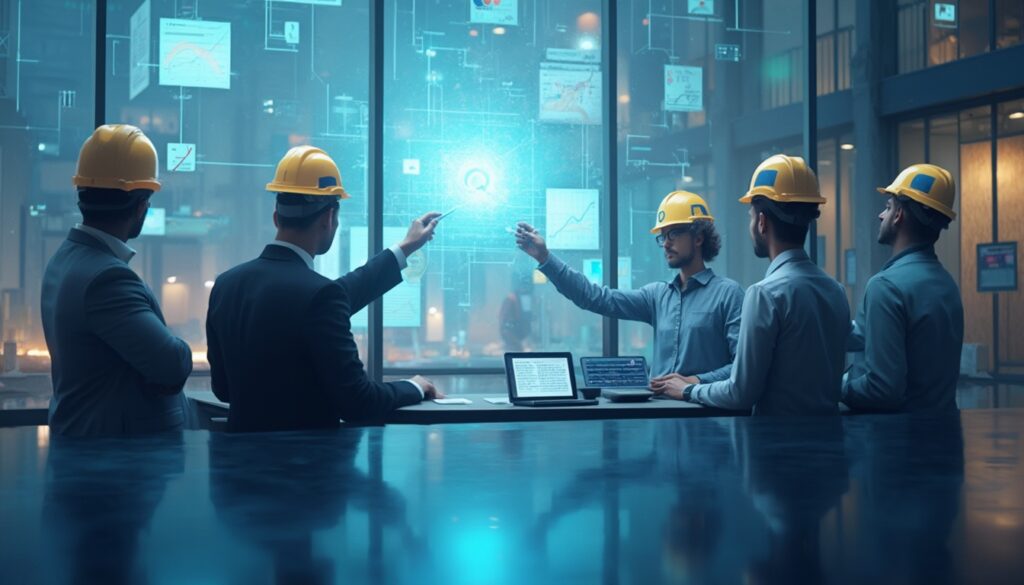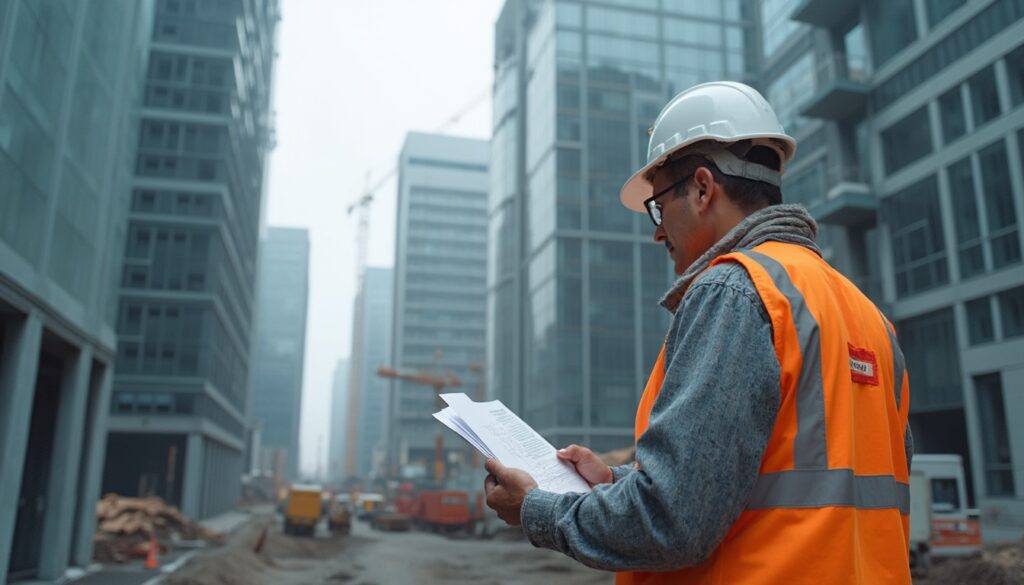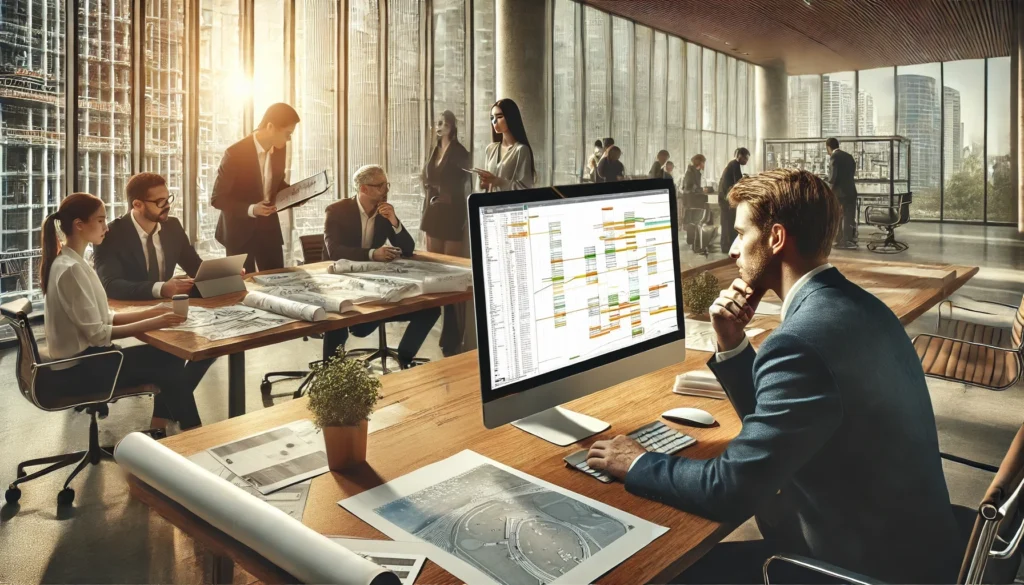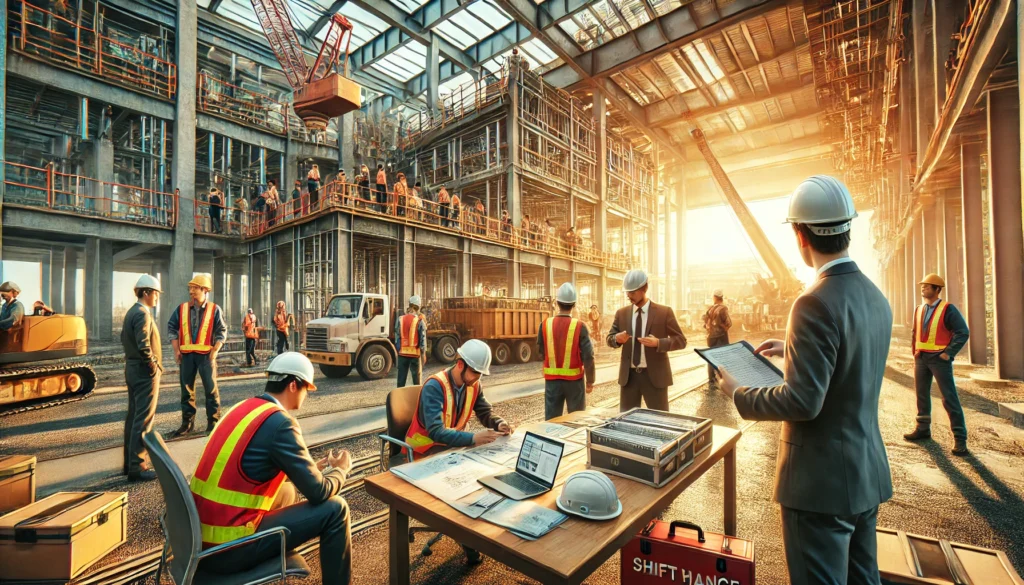Sustainable Construction: Why It Matters Now and How You Can Lay the Foundation
We all feel it: The transformation towards a sustainable construction industry is far more than just a trend – it is a genuine necessity to address the ecological, economic, and social challenges of our time. But what exactly lies behind this important term, and why is it so crucial for companies like yours? In this article, we want to show you how, as a player in the construction industry, you can successfully implement sustainable practices and benefit from the many advantages. This is where we come into play: At Valoon GmbH, we passionately support you in making your projects more efficient and thus more sustainable through optimized communication and data processing. Discover with us how the sustainable construction industry shapes the future of construction and what exciting opportunities this holds for your company in the sustainable construction industry sector. Because one thing is clear: The path to a more environmentally friendly construction method begins with understanding the basics and being open to innovative solutions.
- Die sustainable construction industry is a necessity to meet ecological, economic, and social challenges.
- It involves minimizing resource consumption, reducing environmental impacts, and creating healthy, durable living spaces throughout the entire lifecycle of a building – a core goal for the sustainable construction industry.
- sustainability in the construction industry is crucial for reducing CO2 emissions and waste generation and for meeting regulatory requirements.
- Despite challenges such as transitioning traditional construction methods, it offers immense opportunities like cost savings, improved reputation, and the unlocking of new business areas through innovations.
What does “sustainable construction industry” actually mean?
When we talk about a “sustainable construction industry“, we mean a sector that has sustainability principles firmly in mind in all its activities – from the initial planning idea through to construction and eventual deconstruction of buildings. This specifically means: minimizing resource consumption, reducing environmental impacts, and creating healthy, durable living spaces. At its core, it is about meeting the needs of our current generation without jeopardizing the possibilities for future generations. A central aspect of this is considering the entire lifecycle of a building. The sustainable construction industry aims to balance ecological, economic, and social aspects in order to realize long-term valuable and responsible construction projects. This naturally requires a certain rethinking of traditional processes and the willingness to integrate new technologies and materials.
Why is sustainability in construction so important?
It cannot be emphasized enough: The importance of sustainability in construction is truly immense, as our industry has a significant impact on the environment and society. The numbers speak for themselves: According to the Federal Statistical Office, the direct CO2 emissions of the construction industry in Germany were a remarkable 8 million tons in 2022. And did you know that the construction industry is responsible for around 55% of the total waste generated in the country? A sustainable construction industry is therefore absolutely crucial to reduce these numbers and make a significant contribution to climate protection. It’s about using resources more efficiently, reducing energy consumption, and promoting the circular economy. But not only that: Sustainable construction also enhances the quality of life for users and can help you save costs in the long run. For your company in the sustainable construction industry this also means strengthening competitiveness and meeting increasing regulatory requirements, such as those defined in the EU taxonomy for the construction industry .
A look at challenges and opportunities
Sure, the transformation towards a sustainable construction industry is no walk in the park and comes with challenges, but it also opens up truly significant opportunities! Among the hurdles are certainly the transition from cherished traditional construction methods, sometimes higher initial investment costs for sustainable materials and technologies, and, of course, the need for new expertise and training. The acceptance of new methods in an industry often seen as rather conservative also needs to grow. But let’s look at the other side: the opportunities are immense: Think of cost savings through energy efficiency and lower operating costs, an improved reputation and market positioning, access to funding and green financing, as well as the unlocking of entirely new business areas. The sustainable construction industry benefits enormously from innovations, especially with digital tools, which allow for much better planning and implementation. Companies that recognize and seize these opportunities early secure a decisive competitive advantage for the future of the construction industry.Green Thumb for the Construction Site: Conserve Resources, Reduce Emissions
When we talk about sustainability, the ecological aspect is of course a central pillar of the sustainable construction industry. It’s about drastically reducing the ecological footprint of our construction activities. This specifically means: maintaining a conscious relationship with natural resources, minimizing waste and emissions, and protecting biodiversity. For all of us in the sustainable construction industry there are clear areas of action – it starts with material selection and extends to the design of outdoor spaces. Implementing ecological principles is not only a matter of responsibility that we as sustainable construction industry carry, but is also increasingly becoming a tangible economic factor. As resources become scarcer and more expensive, and regulatory requirements increase, the development of the construction industry clearly points towards more environmentally friendly methods – a path we can only applaud.
- Resource conservation and circular economy: Establish a functioning circular economy by maximizing the reuse of building materials, regional procurement, and concepts like urban mining.
- Reduce CO2 emissions: Adopt a multi-faceted approach to reduce greenhouse gas emissions through lifecycle assessments (LCA), energy-efficient building, and the selection of low-CO2 building materials.
- Minimize environmental impacts: Go beyond CO2 by avoiding harmful substances like PVC, designing biodiverse outdoor spaces, and implementing effective waste management.
- Promote the reuse of building materials: Focus on careful planning (Design for Deconstruction), advanced deconstruction techniques, and material passports to use building materials in new projects.
Resource conservation and circular economy: Here’s how!
A heartfelt concern of the sustainable construction industry is to conserve our natural resources. How can we do this? By establishing a functioning circular economy! The motto “Reuse instead of Dispose” takes on a whole new, important meaning here. This involves maximizing the reuse of building materials and components, for example, through selective deconstruction and creating material exchanges. Regional procurement, that is, “Regional products instead of long transport routes“, is also a smart move: it not only reduces transport emissions but also strengthens the local economy. Another exciting approach is urban mining. Here we view buildings at the end of their lifecycle as valuable resource depots to significantly reduce the need for new primary raw materials. You see, the sustainable construction industry is focusing on truly smart concepts to close material cycles and avoid mountains of waste, a must for any modern sustainable construction industry.
Reuse of building materials: ‘Reuse instead of Dispose’ – but done right!
Imagine if we could simply reuse building materials – this is a crucial lever for a sustainable construction industry! Instead of letting valuable materials end up in landfills after a demolition, we should use them as much as possible in new projects. Of course, this requires careful planning from the design stage (keyword: Design for Deconstruction) and advanced deconstruction techniques. So-called material passports can help us accurately document the materials used and their properties, making later reuse significantly easier. The examples are diverse: from the processing of concrete rubble into recycled concrete to the reuse of entire components like doors, windows, or structural beams. The sustainable construction industry actively promotes the development of markets for secondary construction materials and supports initiatives that raise awareness of the enormous benefits of reuse. This not only reduces waste but also the energy expenditure and CO2 emissions that would otherwise occur in the production of new materials – a win-win situation for the sustainable construction industry!
Reducing CO2 emissions: A must for our future
At the top of the agenda for the sustainable construction industry is the reduction of CO2 emissions – and for good reason, as our sector contributes significantly to global greenhouse gas emissions. This relates to both the so-called “grey energy” involved in the production and transport of building materials and the emissions that occur during the usage phase of buildings through heating, cooling, and lighting. The sustainable construction industry pursues a clever, multi-faceted approach: This includes detailed lifecycle assessments (LCA) of buildings and building materials to uncover optimization potentials, which is of great importance for the sustainable construction industry . Equally important is the construction of energy-efficient buildings, ideally to the point of plus-energy houses, and of course the conscious selection of building materials with the lowest possible CO2 footprint. Renewable raw materials such as wood are playing an increasingly important role here, but also innovative, low-CO2 cements and insulation materials are on the rise. The trends in the construction industry clearly show: It’s moving towards more climate-friendly construction methods.
- Lifecycle assessment (LCA): Here, we take a close look at the environmental impacts of a building – from raw material extraction to deconstruction.
- Energy-efficient construction: This means we focus on top insulation, efficient building technology, and renewable energies to keep energy demand during operation to a minimum.
- Low-CO2 building materials: We prefer materials like wood, clay, or recycled building materials that inherently bind less grey energy.
Minimizing environmental impacts: More than just CO2
But it’s not only about CO2 reduction and resource conservation. The sustainable construction industry also focuses on minimizing other environmental impacts. This includes consciously avoiding harmful substances like PVC on construction sites – our goal: a “PVC-free construction site“, to protect people and the environment from potentially dangerous emissions or tricky disposal issues. Also, the “design of biodiverse outdoor spaces” is a super important aspect. This allows us to create or preserve habitats for plants and animals in urban spaces while positively influencing the microclimate. And, of course, well-thought-out waste management at every construction site is essential – focusing on waste avoidance, consistent separation, and high-quality recycling concepts. The sustainable construction industry takes responsibility for the entire construction process and its impact on our environment. By the way, exciting future technologies in the construction industry can also help us.Sustainable construction, smart savings: The economic strengths
Many think of sustainability in construction first in terms of ecological or social aspects. But did you know that sustainable construction also offers tangible economic benefits? A sustainable construction industry masterfully understands how to combine long-term economic viability with responsible action. This means not viewing investments in sustainable construction methods as purely a cost factor, but rather as a wise strategic decision for value enhancement and risk minimization. The economic aspects are diverse: they include considering the total lifecycle costs, utilizing funding programs, and even developing new business models around the circular economy. For us companies in the sustainable construction industry it is therefore crucial to recognize and purposefully exploit these economic potentials. This way, we remain sustainable construction industry competitive and operate in a future-proof manner. And believe us, the construction industry in 2025 will be greatly influenced by exactly these economic considerations.
- Secure long-term economic viability: Focus on lifecycle cost assessment (LCC) to benefit from lower operating and maintenance costs and higher value stability of sustainable real estate.
- Utilize funding programs and incentives: Learn about national and European funding options (e.g., EU Green Deal) and ESG-compliant financing to improve the economic viability of sustainable projects.
- Establish circular economy as a business model: Recognize and utilize the economic opportunities of urban mining, selective deconstruction, and the trading of secondary construction materials, supported by concepts like ‘Design for Deconstruction’.
Long-term economic viability: Sustainability pays off
A true key factor for success in the sustainable construction industry is long-term economic viability. Instead of merely focusing on the initial construction costs, the so-called lifecycle cost assessment (LCC) is increasingly coming into focus. What does this mean? This analysis truly considers all costs incurred during the entire lifetime of a building – from planning and construction to operation and maintenance, right through to deconstruction. And here it often becomes clear: Sustainably planned buildings score with lower operating and maintenance costs, for instance, due to high energy efficiency or particularly durable materials. This ultimately leads to better overall economic viability. Moreover, sustainable properties often experience higher value stability and are easier to rent or sell, as the demand for environmentally friendly and healthy buildings continues to rise. The sustainable construction industry therefore focuses on investments that pay off not only in the short term but especially in the long term, a core principle of the sustainable construction industry.
Funding programs and incentives: Tailwind for green projects
Fortunately, to facilitate the transition to a sustainable construction industry even faster, there are plenty of funding programs and financial incentives available – both at the national and European levels. The for example sets ambitious targets and allocates significant resources to stimulate sustainable investments. Furthermore, banks and investors are keenly scrutinizing and increasingly valuing sustainability aspects (the well-known ESG criteria) when financing construction projects. What does this mean for you? Companies that are active in the sustainable construction industry and align their projects accordingly can often benefit from low-interest loans, grants, or tax advantages. It’s a sign of the maturing sustainable construction industry. Thus, it pays off to early inform oneself about available funding opportunities within the framework of the EU taxonomy and other programs and to use them purposefully for the realization of your sustainable construction projects. This can significantly improve the economic viability of sustainable projects!
Circular economy as a business model: Recognize and utilize potentials
It’s exciting to see how the circular economy in the sustainable construction industry is evolving from a pure necessity into a genuinely attractive business model! Urban mining, i.e., the clever recovery of raw materials from existing structures, is becoming increasingly economically interesting due to rising raw material prices and CO2 pricing. Companies specializing in selective deconstruction, processing, and the trading of secondary construction materials are tapping into entirely new value chains. The principle ‘Design for Deconstruction‘ – which means designing buildings in such a way that they can be easily dismantled at the end of their lifespan and their components reused or recycled – is a genuine success factor. The sustainable construction industry is increasingly recognizing the economic opportunities lying in closed material cycles, investing in innovative technologies and processes to harness these potentials. This is not only good for resource conservation but also creates new jobs and exciting business fields.Building with heart and mind: People at the center of sustainable projects
Alongside ecology and economy, one aspect must never be overlooked: the social dimension of sustainability. It is an absolutely integral part of a future-oriented sustainable construction industry and places people at the center – both the future users of the buildings and the dedicated workers on the construction sites as well as the communities where we build. What matters to us? Creating healthy, safe, and inclusive living and working spaces, ensuring fair working conditions, and making a positive contribution to societal development. For us companies in the sustainable construction industry this means looking beyond purely technical and economic aspects and actively taking on our social responsibility. This not only strengthens our image as part of the sustainable construction industry, but also significantly contributes to employee satisfaction and the acceptance of our construction projects in the population. We are convinced: The future of the construction industry will largely depend on how well we manage to integrate these social aspects.
Health and well-being of users: More than just four walls
A central concern of social sustainability in the sustainable construction industry is to promote the health and well-being of the people who use our buildings. This starts with the creation of healthy indoor air quality – through the use of low-emission construction materials and thoughtful ventilation. Additionally, natural lighting, pleasant room temperatures, and good acoustics significantly contribute to user comfort. Furthermore, accessibility plays an enormously important role to ensure that buildings are accessible and usable for everyone, regardless of physical limitations. Inclusion means for us also considering the needs of diverse user groups already in the planning phase. The sustainable construction industry relies on concepts that are not only energy-efficient but also promote a healthy living environment and user-friendliness – to sustainably improve the quality of life.
Working conditions on construction sites: Fair and safe for everyone
Naturally, the sustainable construction industry also bears significant responsibility for the people who give their best every day on our construction sites. Worker safety and health protection are our highest priorities. This includes accident prevention through thorough training, safe equipment, and well-organized workflows, as well as protecting against long-term health risks from noise, dust, or hazardous substances. Fair working conditions, adequate remuneration, and strict adherence to working hour regulations are a part of our ethical business practices. And we believe that companies in the sustainable construction industry should also ensure that their subcontractors adhere to these standards. Because good working conditions lead not only to more motivated employees and higher work quality, but they are also a clear sign of responsible corporate management. By the way, we at Valoon GmbH see a point of approach for our software here: improved communication and seamless documentation can make an important contribution to safety on construction sites, ensuring that clear instructions and information are always available for everyone, thus supporting the sustainable construction industry .
Contribution to the local community: Creating value together
Every construction project inevitably has impacts on the local community. An sustainable construction industry aims to make these effects as positive as possible. How can this be achieved? For example, by creating jobs for local workers, both during the construction phase and in the later operation of the buildings. Involving local businesses and suppliers is also an important point, as it strengthens the regional economy. Additionally, construction projects can make a real contribution to social integration by, for example, creating meeting places or improving local infrastructure. Crucially, early and transparent communication with residents and local stakeholders is essential to promote acceptance and prevent potential conflicts from the outset. The sustainable construction industry understands itself as an active part of society and wants to contribute to the development of livable communities.Innovations that inspire: Smart technologies for the sustainable construction site
Without innovative technologies and materials, it’s not possible – they are truly the driving forces for the exciting transformation toward a sustainable construction industry. They enable us to have more efficient processes, help reduce resource consumption, and open up entirely new avenues for environmentally-friendly construction. Digitalization, especially Building Information Modeling (BIM), plays an absolutely key role here, as it allows for data-driven planning and execution that was previously unimaginable. Moreover, advancements in modular construction, 3D printing, and the development of new, sustainable building materials significantly contribute to the development of the construction industry . For us companies in the sustainable construction industry it is therefore super important to know and purposefully deploy these innovations. Only in this way can we as sustainable construction industry achieve our sustainability goals and remain competitive. This is precisely where we at Valoon GmbH come in: We firmly believe that simplifying data collection and processing, for example through clever integration of messaging services, can significantly contribute to increasing efficiency and thus also to sustainability.
Digitalization and Building Information Modeling (BIM): The revolution in planning and building
Digitalization, particularly Building Information Modeling (BIM), is revolutionizing the way things are done in the sustainable construction industry. Imagine, BIM allows for the creation of a digital twin of a structure that contains all relevant information over the entire lifecycle – a real game changer! This leads to a significant increase in efficiency through data-driven decisions in planning, construction, and later operation. Resource consumption can be forecasted and optimized much more accurately, collisions can be detected and avoided early. And the improved collaboration of all project participants through a shared data platform? It significantly reduces errors and misunderstandings. The sustainable construction industry utilizes BIM cleverly to simulate energy demand, support the selection of sustainable materials, or even plan the later dismantling and reuse of components. For us in the sustainable construction industry it is clear: The digitalization of the construction industry is an absolutely indispensable lever for more sustainability.
Modular construction and prefabrication: Efficient and resource-saving
Modular construction and prefabrication are gaining importance in the sustainable construction industry for good reason! In this approach, components or even entire modules are prefabricated under controlled conditions in the factory and then quickly assembled on site. The result? A significant reduction of waste and construction time compared to traditional construction. The precision and quality of components can often be enhanced through industrial manufacturing. Furthermore, weather influences can be minimized and work processes optimized. The sustainable construction industry benefits from modular construction through better planning and reduced noise and dust nuisance on site – a blessing for residents and workers and a step forward for all. sustainable construction industry. Especially in serial projects or when it comes to approaches like Lean Construction , prefabrication fully showcases its strengths and significantly contributes to a more resource-efficient construction method.
3D printing in construction: The future is taking shape
Another exciting technology with significant potential for the sustainable construction industry is 3D printing in construction. Through the layer-by-layer, additive application of material, not only complex geometric shapes can be realized, but material consumption can also be precisely controlled. This holds massive potential for reducing material consumption and labor costs. Waste is minimized, and even recycled or bio-based materials can be used in the printing process – how cool is that? Although the technology is still in development, initial pilot projects already impressively demonstrate the feasibility and benefits of 3D printing, especially in the production of formwork or entire wall elements. The sustainable construction industry is observing this development with great interest, as it could open up entirely new possibilities for resource-efficient and customized building. We are confident: The future of digital construction will also be significantly influenced by 3D printing.
- What are the advantages of 3D printing? Clearly: reduced material waste, potentially faster construction times for certain elements, and enormous design freedom.
- Are there also challenges? Yes, of course: scalability for large projects, the further development of suitable materials, and regulatory approvals are issues that are being worked on.
- Where is it already being used? For example, in the creation of prototypes, custom components, or even small residential units.
Guide in the label jungle: What construction certifications really accomplish
Certifications and standards – an important topic when it comes to the sustainable construction industry ! They play a really significant role, as they provide a reliable framework for the planning, implementation, and evaluation of sustainable buildings. One can imagine them as a kind of guide for builders, planners, and executing companies that make the sustainability performance of a building transparent and comparable. Well-known systems like DGNB or LEED assess buildings based on a wide variety of criteria from ecology, economy, and social aspects. For us companies in the sustainable construction industry , a certification can not only impressively demonstrate the quality and future viability of our projects but also improve marketing opportunities and facilitate access to financing. However, and this is important for us to emphasize, one should always view certifications with a critical eye and understand exactly what they actually signify for the sustainable construction industry and where their limitations might lie. Compliance with overarching standards like the EU Taxonomy is becoming increasingly relevant here.
DGNB (German Sustainable Building Council): Quality from Germany
A well-known example from Germany is the system of the German Sustainable Building Council (DGNB). They have developed a truly comprehensive certification system that enjoys high prestige both in the sustainable construction industry here at home and internationally. The great thing about the DGNB system is that it assesses the sustainability of buildings and even entire districts holistically over the entire lifecycle. There are various certification options, tailored precisely to different types of use and project phases – be it new construction, existing buildings, interiors, construction sites, or even building deconstruction. The evaluation is based on criteria from six main thematic areas: Ecological quality, Economic quality, Sociocultural and Functional quality, Technical quality, Process quality, and Location quality. Not to forget: The DGNB Academy plays an important role in the training of experts such as auditors and consultants for sustainable construction and thus significantly contributes to the dissemination of valuable expertise in the sustainable construction industry . We can therefore warmly recommend a sustainable construction industry to professionals to advance the
LEED (Leadership in Energy and Environmental Design): The international standard
Another internationally widespread system is LEED (Leadership in Energy and Environmental Design), which was initiated by the U.S. Green Building Council (USGBC). Similar to DGNB, LEED evaluates buildings based on various criteria, including energy efficiency, water efficiency, material selection, space quality, and site development. LEED offers various certification levels – from Certified to Silver, Gold, and Platinum – and is also applicable to different building types and project phases. For internationally operating companies in the sustainable construction industry , a LEED certification can be a real advantage to make the sustainability performance of their projects globally comparable and visible. The decision of whether DGNB or LEED is the more suitable system often depends on the specific project requirements and the geographical context. But one thing is clear: Both systems significantly contribute to continuously raising the standards for sustainable building in the sustainable construction industry .
Critical examination of certifications: What they really signify (and what they do not)
Although certifications like DGNB and LEED are very valuable for the sustainable construction industry , a small critical examination is certainly appropriate. After all, a certification alone is not an automatic guarantee that a building is optimally sustainable in every respect. The systems often rely on point schemes, and it is theoretically possible to achieve high ratings even if there may still be weaknesses in certain areas. Moreover, some certificates place a stronger focus on specific aspects of sustainability than others. Therefore, it is so important to understand the criteria and methodology behind a certification and not blindly trust the label. Also, the actual performance of a building during later operation can sometimes differ from the certified values. Nevertheless, certifications provide an enormously important orientation and promote healthy competition for ever better solutions in the sustainable construction industry. They are a valuable tool that we must use wisely to promote true sustainability – ideally complemented by continuous monitoring and optimization. If you want to dive deeper into the details of the certification criteria, it can be very helpful to consult a Sustainable Construction PDF directly from the certification bodies.Models that inspire: This is how sustainable construction works in practice!
The best way to learn is often from others, right? That’s why best practices and exciting case studies are simply essential to make the immense potentials and practical implementation of sustainability in the sustainable construction industry tangible. They impressively show us that ambitious sustainability goals are absolutely achievable and often go hand in hand with innovative solutions and economic success. Projects like the famous Ice Bear House or the initiatives of companies like Nokera serve as great inspiration and provide valuable insights into successful strategies. But international examples like Park 20|20 in the Netherlands also show how circular construction can work exceptionally well in practice. By analyzing such examples of sustainable construction , we can all learn from the experiences of others and implement our own sustainable projects even more successfully. These pioneering projects are often also a showcase for the sustainable construction industry von den Erfahrungen anderer lernen und unsere eigenen nachhaltigen Projekte noch erfolgreicher umsetzen. Diese Vorreiterprojekte sind oft auch ein Schaufenster für die current trends in the construction industry and for the entire sustainable construction industry.
The Ice Bear House: A lighthouse project for sustainable construction
Do you know the Ice Bear House? It is a truly often-cited model example of outstanding sustainable construction and beautifully demonstrates the principles of the sustainable construction industry. When you take a closer look at its design features, you immediately notice the highly efficient insulation, the clever use of passive solar energy, and the integration of renewable energy technologies like photovoltaics and solar thermal energy. But the resource efficiency is also impressive: ecological building materials are used, often wood from sustainable forestry, and systems for rainwater utilization are integrated. A direct comparison with conventional construction methods quickly shows: There are significant savings in energy consumption and CO2 emissions over the entire lifecycle! The Ice Bear House concept, often found in the context of passive houses or positive energy houses, is the best proof that the highest residential comfort and minimal environmental impact can go hand in hand wonderfully. This makes it a true lighthouse project for the entire sustainable construction industry and shows what is possible in the sustainable construction industry .
Nokera: Serial production with sustainable materials – clever and efficient
Another exciting example is Nokera. This company is making a name for itself in the sustainable construction industry by focusing on the serial production of buildings while consistently using sustainable materials, especially wood. Nokera’s business model is quite clever: it is based on an integrated value chain – spanning from sustainable wood procurement to digitized planning (often with BIM, as we have already discussed) to the industrial prefabrication of building elements and their rapid assembly on the construction site. This approach enables impressive efficiency, consistently high quality, and pleasingly short construction times. Nokera also places great importance on high ESG standards (Environmental, Social, Governance) and the use of renewable energy in its own production processes. The company is a great example of how economies of scale can be used in the sustainable construction industry to make environmentally friendly construction economically attractive even for larger projects. It is companies like these that are driving the transformation of our industry! Further successful projects and initiatives that inspire
Weitere erfolgreiche Projekte und Initiativen, die inspirieren
But the Ice Bear House and Nokera are certainly not the only ones! There are numerous other inspiring projects and initiatives that highlight the impressive diversity and innovative strength of the sustainable construction industry . For example, Park 20|20 in the Netherlands – considered one of the first Cradle-to-Cradle-optimized office districts in the world, it truly impressively demonstrates the principles of circular construction. Here, materials have been selected and built in such a way that they can be easily separated at the end of their useful life and either reused or recycled. Initiatives like Circular London are also doing great work by promoting the circular economy in the construction sector through networking, knowledge exchange, and exciting pilot projects. These examples show us that the sustainable construction industry does not only look at individual buildings but also pursues broader, urban and regional approaches to achieve a truly comprehensive transformation. The examples of sustainable architecture are so diverse and inspiring – it is worth taking a closer look!
- Park 20|20 (Netherlands): Here, the focus is clearly on Cradle-to-Cradle principles, i.e., material health and maximum reusability.
- Circular London: A great initiative that actively promotes the circular economy in the London construction industry.
- Research projects on urban mining: Here, strategies and technologies are developed to recover raw materials directly from the existing building stock – super exciting!
Overcoming hurdles, seizing opportunities: How to make sustainable construction a success
Honestly: The path to a widespread sustainable construction industry is not always a walk in the park and is unfortunately paved with various challenges. It starts with the acceptance of new methods in often traditionally shaped structures, goes through the lack of qualified professionals, and leads to regulatory hurdles that can sometimes unnecessarily slow down innovative approaches. But cheer up! For each of these challenges, there are solutions that we companies in the sustainable construction industry can pursue to actively shape the change. A proactive approach, smart investments in education, and a willingness to adapt are absolutely crucial to overcoming these hurdles and enjoying the many benefits of sustainable construction. sustainable construction industry to fully utilize. We are convinced that the development of the construction industry depends significantly on how well we master these challenges together.
Acceptance in traditional industries: Making a case for it
One of the biggest hurdles for the sustainable construction industry is, we have to say, the often still hesitant acceptance of new methods and technologies. Our industry is strongly shaped by traditions and established processes. To counter this, targeted education and extensive sensitization are absolutely essential. It is our task to communicate the benefits of sustainable construction not only ecologically but, above all, economically clearly. By demonstrating the economic advantages through successful pilot projects and case studies, we can help to dispel existing reservations. Equally important are training and further education for truly everyone involved – from planners to tradespeople to clients. Only in this way can we convey the necessary knowledge and skills for the implementation of sustainable building practices. The sustainable construction industry must actively advocate for its concerns and show the great opportunities that arise from this change. By the way, our software solutions at Valoon GmbH can also make a small but fine contribution here, for example, by significantly simplifying the documentation of sustainable building materials and processes.
Shortage of Skilled Workers: Knowledge Transfer and Promotion of Young Talent
Another issue that preoccupies us in the sustainable construction industry is the shortage of qualified skilled workers. This is truly a significant challenge, as sustainable construction requires specific knowledge about new materials, innovative technologies, and adapted planning methods. To address this shortage, we all need to make intensified efforts in education and training . This means that vocational schools, universities, and training institutions are called upon to adapt their curricula to the current requirements of the sustainable construction industry . But we companies are also obligated: We should invest in the qualification of our employees and showcase attractive career paths for skilled workers in the field of sustainable construction. Promoting young talent – whether through internships, trainee programs, or close collaboration with educational institutions – is also absolutely critical to securing enough experts for the many exciting tasks in the long term. Perhaps even a Bachelor’s thesis in Sustainable Construction could be the perfect entry point for young talents in this future field?
Regulatory Hurdles: Modernizing Framework Conditions
And then there are sometimes the regulatory framework conditions that can hinder rather than promote the development of the sustainable construction industry . Outdated building codes or guidelines may not sufficiently consider new sustainable building materials or innovative construction methods, or make their approval unnecessarily complicated. Here, an open and constructive dialogue between us actors in the sustainable construction industry, the political sphere, and the responsible authorities is absolutely necessary to achieve a sensible adaptation of building codes and guidelines. At the same time, positive incentives, such as simplified approval procedures for particularly sustainable projects or tax advantages, can significantly promote development. What we need are clear and reliable framework conditions. These are important to ensure investment security and actively support innovations in the sustainable construction industry . A transparent Sustainable Construction Certification can help establish important standards and build trust.Building for Tomorrow: Join Us in Shaping the Future of Sustainable Construction!
When we talk about the sustainable construction industry , we are not at the end of a development – quite the opposite! We are right in the middle of an incredibly exciting and profound transformation that will decisively shape the construction of tomorrow. Current trends and developments all point towards a future where circular economy, climate neutrality, and digitalization will inevitably become the standard. However, this change requires not only technological innovations, as important as they are. It also requires a change in mindset across society and supportive political framework conditions. And this is precisely where we see our role at Valoon GmbH: We firmly believe that truly efficient communication and intelligent data management, as enabled by our software, are absolutely crucial building blocks for a successful sustainable construction industry . By simplifying your processes and optimizing information flows, we want to help you make your construction projects more sustainable and thus more future-proof, as part of the evolving sustainable construction industry. Explore the enormous potentials together with us and actively shape the future of the construction industry with us!
Trends and Developments: What Can We Expect?
Die sustainable construction industry is incredibly dynamic – there are constantly new trends and exciting developments. We see clearly: The circular economy is increasingly becoming the standard, simply because resources are becoming scarcer and we all have the desire to minimize waste. The major goal of climate-neutral construction is also coming into greater focus. This means that the use of renewable energy and low-CO2 materials will be further pushed. At the same time, digitalization is a real driver: In particular, BIM and well-planned digital construction processes significantly advance efficiency and transparency. And who knows, perhaps automation and robotics will soon play an even bigger role in optimizing construction processes and relieving our valuable skilled workers. The sustainable construction industry will certainly continue to be characterized by innovative materials, intelligent building technology, and clever new business models. For all of us in the sustainable construction industry , it is crucial to recognize and wisely integrate these trends in the construction industry early on into our business strategy.
The Role of Politics and Society: Shaping Change Together
For the transformation towards a truly comprehensive sustainable construction industry to succeed, the interplay between politics and society is needed – both play an absolutely crucial role. Politics is called upon to actively support development with clear legal framework conditions, suitable funding programs, and smart incentives. This includes promoting innovations, adapting norms and standards, and a fair pricing of environmental impacts. At the same time, a societal change in mindset is also necessary: An increased awareness of sustainability among clients, investors, and later users can significantly increase demand for sustainable buildings and thus accelerate the change. Education and enlightenment are, of course, very important tools here. And we, the sustainable construction industry, can actively shape this process by communicating transparently about our efforts and clearly highlighting the many advantages of sustainable construction for the entire society and the sustainable construction industry .
Call to Action: What Can You and We Do Now?
Designing a sustainable construction industry is a real community task, to which every individual and every company can contribute valuable input. It starts with the willingness to question traditional ways of thinking and to be open to new, sustainable solutions. Inform yourself about sustainable building materials, energy-efficient technologies, and the many possibilities to reduce waste. Rely on digital tools to plan and implement your projects more efficiently. The sustainable construction industry offers so many entry points to make a positive contribution! We at Valoon GmbH are more than happy to support you in optimizing your communication and project management processes and thus conserving valuable resources. Let’s not kid ourselves: The decision for a sustainable construction industry is an investment in all our futures. It not only reduces costs and environmental impacts but also enhances the quality and value of your construction projects. We believe now is the perfect time to explore the opportunities for your company. Don’t hesitate and contact us today!! Let’s start with a personalized consultation and align your projects for the future.
- Inform and Educate: Stay curious and informed about new sustainable technologies and methods.
- Choose sustainable materials: Give preference to building materials with a low ecological footprint and good recyclability.
- Increase energy efficiency: Plan and build buildings that require as little energy as possible in operation.
- Avoid and recycle waste: Implement a truly consistent waste management system on your construction sites.
- Use digital tools: Optimize your processes through the smart use of software solutions – like those from us at Valoon GmbH.
What does “sustainable construction industry” concretely mean for my construction company?
For your construction company, “sustainable construction industry” means that you consider ecological, economic, and social aspects in all your processes. This ranges from the selection of materials and energy efficiency to waste reduction to the improvement of working conditions and the long-term economic viability of your projects.
What direct benefits does the transition to sustainable construction bring me?
Sustainable construction offers you significant cost savings through lower energy and material consumption, an enhanced reputation and competitiveness. Moreover, you secure the access to funding and meet increasing regulatory requirements, such as the EU taxonomy.
Isn’t sustainable construction too expensive and complicated for my company?
Initial investments may be higher, but in the long run, sustainable measures often pay off through lower operating and maintenance costs. Solutions like the software from Valoon GmbH also help simplify processes and reduce complexity , for example, by collecting data through familiar messaging services., indem z.B. die Datenerfassung über bekannte Messenger-Dienste erfolgt.
How can digitalization, e.g., through software, help with sustainable construction projects?
Digitalization, such as through project management software, enables more efficient planning, communication, and documentation. This leads to optimized resource utilization, fewer errors, and better traceability of sustainability aspects, which saves time and costs. Valoon GmbH focuses here on the simplification of data collection directly from the construction site.
What is meant by circular economy in construction and how can I benefit from it?
Circular economy in construction means keeping materials in the usage cycle for as long as possible, e.g., through reuse and recycling. You benefit from lower disposal costs, potentially cheaper secondary raw materials and the emergence of new business models, such as the deconstruction and processing of building materials.
Do I have to switch all my construction processes to achieve more sustainability immediately?
No, a transition can occur gradually. Start with easily implementable measures like improved waste management or the digital collection of construction site data. It is important to make a start and continuously optimize processes to keep entry barriers low..
How can I effectively reduce the CO2 emissions of my construction projects?
You reduce CO2 emissions by employing energy-efficient construction methods, selecting low-CO2 building materials (e.g., wood, recycled materials), optimizing transport routes and utilizing renewable energy. erneuerbarer Energien on the construction site and in the building.
What role do certifications like DGNB play for my company?
Certifications like DGNB provide a recognized proof of sustainability performance of your buildings. They can improve the marketing opportunities, facilitating access to financing and serve as a quality seal for customers and partners.
